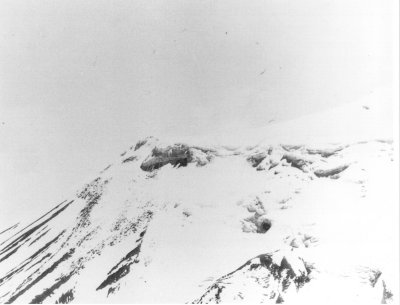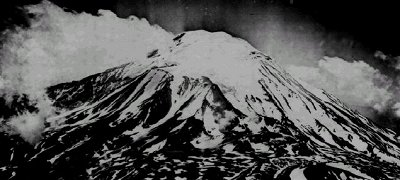
Analysis of 1949 Ararat Anomaly Photographs
by Jim Hays
Abstract:
This report summarizes an analysis of de-classified photographs of the "Ararat Anomaly". The anomaly is located on the ice cap of Greater Mount Ararat, on a steep slope just below the rim of the western plateau. The photographs were taken by a USAF aircraft on June 17, 1949. After detailed analysis and comparison of the two photographs, the author has determined that the anomaly is a natural formation rather than a manmade object.
Analysis of Photograph #1 (Frame 2):

In this photograph the anomaly has the general appearance of a large boat, broadside the camera, surrounded by ice and snow. There is no conclusive evidence in the photograph, however, that the anomaly is indeed manmade. On the other hand, it would be equally difficult to determine that the anomaly is a natural formation from this view alone. Though contrary to the final conclusion, terminology describing a manmade object will be used to assist the reader in locating the individual features being discussed in this photograph.
The anomaly appears to be shaped like a boat with a light gray "upper hull" and a dark charcoal gray "lower hull". The body line between the upper and lower "hulls" appears to be somewhat linear, except for some slight curves and jogs. The two "hulls" appear to form a rounded point on the left side and an evenly squared-off end on the right side. Within the right side of the "lower hull" are some large black areas which are difficult to see. Also, within the left side of the "lower hull" are some black speckles which will be commented on later.
There appears to be a rectangular object resembling an open "door" just left of center of the "upper hull". The "door" appears to be recessed somewhat compared to the rest of the "upper hull", and deteriorated on the lower right. The bottom of the "door" appears to stop at the body line between the upper and lower "hulls". There also appears to be an irregular shaped protrusion in the center of the "door".
The lower middle portion of the "lower hull" appears to be partially hidden by fresh snow which has drifted up against it. There also appears to be extensive ice overhangs above most of the "upper hull". The dark areas above the "upper hull" appear to be shadows caused by these ice overhangs. A large chunk of ice resting on top of the left side of the "upper hull" appears to have broken loose and about to slide off.
A couple things in this photograph lend themselves to a natural formation. These include the curves and jogs in the body line between the two "hulls". Most notable, however, are the black speckles on the left side of the "lower hull", which are directly above similar speckles in the icy slope below the anomaly. The latter appear to be small exposed rocks. The presence of black speckles on the "lower hull", as well as the icy slope below it, suggest that the "lower hull" is actually a shaded portion of the slope rather than a manmade object.
Analysis of Photograph #2 (Frame 23):

In this photograph the anomaly is viewed from a different angle and appears to be a large wave of ice and snow. A careful analysis reveals that all the features seen in photo #1 are visible on the downhill side of this formation. The surrounding terrain is also visible, providing valuable shadow angle information. From this vantage point, there is fairly conclusive evidence that the anomaly is a natural formation rather than a manmade object.
The anomaly, as viewed in this photograph, is clearly a large wave of ice and snow. The "upper hull", seen in photo #1, is actually a vertical edge on the downhill side of the ice wave. This feature is wavy and shaped like a ribbon rather than planar like a manmade wall. It is not in the direct sunlight, accounting for its gray color. The "lower hull", seen in photo #1, is actually a dark shadow on the icy slope below the vertical edge of the ice wave. This shadow is being cast by overhanging ice above the vertical edge. The middle portion of the "lower hull", which appeared to be hidden by a snow drift in photo #1, is actually an unshaded portion of the icy slope below the ice wave. The linear feature between the "hulls", seen in photo #1, is actually the line where the vertical edge of the ice wave meets the icy slope below it. The ribbon-like shape of the vertical edge accounts for the curves and jogs seen in photo #1.
The "door", seen in photo #1, is difficult to see from this angle, but appears to be a recessed, or collapsed section of the vertical edge of the ice wave. The squared-off right side of the two "hulls", seen in photo #1, is also difficult to see from this angle, but appears to be the far right edge of the ice wave.
The black speckles on the left side of the "lower hull", seen in photo #1, are clearly visible in this photograph. As suggested from photo #1, they are indeed small exposed rocks within the shaded portion of the icy slope below the ice wave. This area of small exposed rocks continues down the icy slope into the sunlit portion of the slope. The large areas of black on the right side of the "lower hull", which were barely visible in photo #1, are actually three large exposed rocks on the icy slope below the ice wave.
The large chunk of ice which appeared ready to slide off the left side of the "upper hull" in photo #1, is actually the top left portion of the ice wave, which slopes down to a rounded point. Except where shadowed by overhanging ice, this feature is in the direct sunlight, accounting for its brightness compared to the light gray vertical edge of the ice wave.
Conclusion:
Based on the analysis presented, it has been determined that the anomaly seen in photo #1 (frame 2) of the June 17, 1949 photographs, is actually a natural formation of ice and snow, along with its related shadows. A detailed comparison of individual features in the two photographs proved to be the key to this conclusion.